Is your building’s elevator service plan saving you money—or costing you more than it should?
For many facility managers and building owners, elevator maintenance can feel like a reactive process: fix it when it breaks, schedule a visit when tenants complain. But this approach can lead to higher repair costs, extended downtime, and tenant dissatisfaction. The good news? A well-structured elevator maintenance plan doesn’t have to break your budget—and can actually lower long-term expenses.
Whether you manage a commercial high-rise, medical facility, or multi-unit residential property, creating a cost-effective elevator maintenance strategy is essential for safety, compliance, and long-term asset performance. Here’s how to do it smartly.
The Cost of Inaction: Why Proactive Maintenance Matters
Deferred or inconsistent elevator maintenance can lead to:
-
Frequent service interruptions
-
Higher emergency repair costs
-
Code violations or fines
-
Tenant complaints or lost leases
Emergency callouts and last-minute repairs often cost significantly more than scheduled maintenance. Over time, minor issues can evolve into major mechanical failures. A cost-effective plan minimizes surprises by prioritizing consistency and efficiency.
Key Elements of a Cost-Effective Maintenance Plan
1. Assess Your Current System’s Age and Usage
Start by understanding your elevator system:
-
How old is the equipment?
-
How many floors and trips per day does it serve?
-
Are there recurring issues or component failures?
Older systems or those in high-traffic buildings may require more frequent inspections or targeted upgrades to remain cost-efficient.
2. Choose the Right Service Frequency
Not every building needs monthly service visits. A cost-effective plan is tailored to usage patterns. For example:
-
High-rise commercial buildings may need monthly checkups.
-
Low-rise residential buildings may do well with quarterly service.
Work with a professional to define the right cadence—enough to prevent issues, but not more than necessary.
3. Prioritize Preventative Over Reactive Maintenance
Preventative maintenance—such as lubrication, adjustments, safety checks, and part inspections—extends the lifespan of components and reduces emergency repair needs.
Focus on:
-
Door operators (commonly overused parts)
-
Hydraulic fluid checks
-
Alarm and communication system tests
-
Control system calibration
4. Understand What’s Covered in Your Contract
A surprising cost trap? Maintenance contracts that don’t cover key items. Make sure your plan includes:
-
Labor for routine maintenance
-
Emergency service terms
-
Cost structure for parts and replacements
-
Response time commitments
A transparent agreement allows you to budget better and avoid unexpected bills.
5. Factor in Long-Term Planning
Budgeting for maintenance should include future modernization goals. If your elevator is approaching the 20-25 year mark, start planning for phased upgrades. It’s more cost-effective to modernize incrementally than to face full-system failure.
Partnering for Efficiency and Peace of Mind
A maintenance plan isn’t one-size-fits-all. The most cost-effective strategies come from providers who understand your building’s needs, usage levels, and future goals. At DC Elevator, we help building owners craft smart service plans that reduce downtime, extend equipment life, and keep tenants happy.
Conclusion
A cost-effective elevator maintenance plan is more than a line item in your budget—it’s a strategic investment in your property’s safety, performance, and value. With the right partner and plan in place, you can avoid costly emergencies and ensure your elevator operates efficiently for years to come.
If your current plan feels outdated or too reactive, we can help. Our team offers customized maintenance strategies that align with your building’s needs and budget. Contact us today to request an elevator service evaluation.
